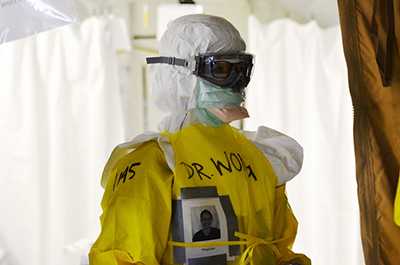Stories From the Field: Inside an Ebola Treatment Unit

Dr. Karen Wong ready to admit a patient
Channeling the mentality of a scuba diver helped Karen Wong, M.D., M.P.H. work safely and effectively inside an Ebola treatment unit (ETU). “Once you put your personal protective equipment on, your countdown starts in terms of how long you’re able to stay in there comfortably,” explained Dr. Wong. Like a diver underwater, she needed to go into the ETU with a dive plan. “It’s important to figure out what everyone needed to do before entering the ETU,” she added.
Dr. Wong was part of the first team deployed to work at the Monrovia Medical Unit in Liberia. She had worked in the Emergency Operations Center (EOC), but wanted to put her clinical skills to use and was able to do so when she was asked to deploy with the U.S. Public Health Service. “I also understood the public health context of what this epidemic means and knew I could be useful on the ground.”
Your Safety First
Dr. Wong did not dive head first into the ETU. “Part of what let me keep going with doing this kind of scary, high risk work was knowing that I had been trained really well in keeping myself safe.” She was one of the 450 healthcare workers who participated in the 3-day training course in Anniston, Alabama, that teaches medical professionals about personal protective equipment (PPE), how to use it, and how to stay safe as they administered care to patients with Ebola.
“One thing they really focused on during training was our personal safety. If you compromise your safety while treating your first patient, you won’t be able to help the next one,” said Dr. Wong.
Before and after being inside the ETU, Dr. Wong and the other healthcare providers would take time to recover. A lot of fluids were lost just through sweat. “After exiting the high-risk zone, our vital signs were taken to make sure we weren’t having heat stress. We would start rehydrating and then sit down and write our doctor’s notes,” explained Dr. Wong.
Communicating Between All the Layers
Communicating between all the layers of PPE, with the roar of the generators and air conditioning, was a challenge, so workers used other means to communicate in the ETU. “Your ears are covered and the person you’re trying to talk to has a respirator and mask over his face so his voice is muffled,” said Dr. Wong.
Spatial awareness was also critical in working efficiently inside the ETU. Healthcare workers needed to pay attention to the whereabouts of their colleagues to pick up on signals, avoid collisions, and make sure they were still okay. “We would do things like make subtle hand gestures to indicate intended movements or tap our foot against the floor to get someone’s attention,” said Dr. Wong.
Make It Like the First Time
“When people do something dangerous enough times, they start to feel more comfortable and may move through the process a little faster,” said Dr. Wong. Healthcare workers in an ETU cannot become complacent. PPE must be donned (put on) and doffed (removed) correctly in proper order every time to prevent exposure to the virus. It is a slow and deliberate process.
Before entering the ETU, Dr. Wong and the other healthcare worker would check each other, making sure there were no breaches in their PPE. She recalled, “Before we entered the high-risk zone, we would always take a deep breath, focus, and remind ourselves to be as careful as we were the first time we went in.”
- Page last reviewed: April 29, 2015
- Page last updated: April 29, 2015
- Content source:




 ShareCompartir
ShareCompartir